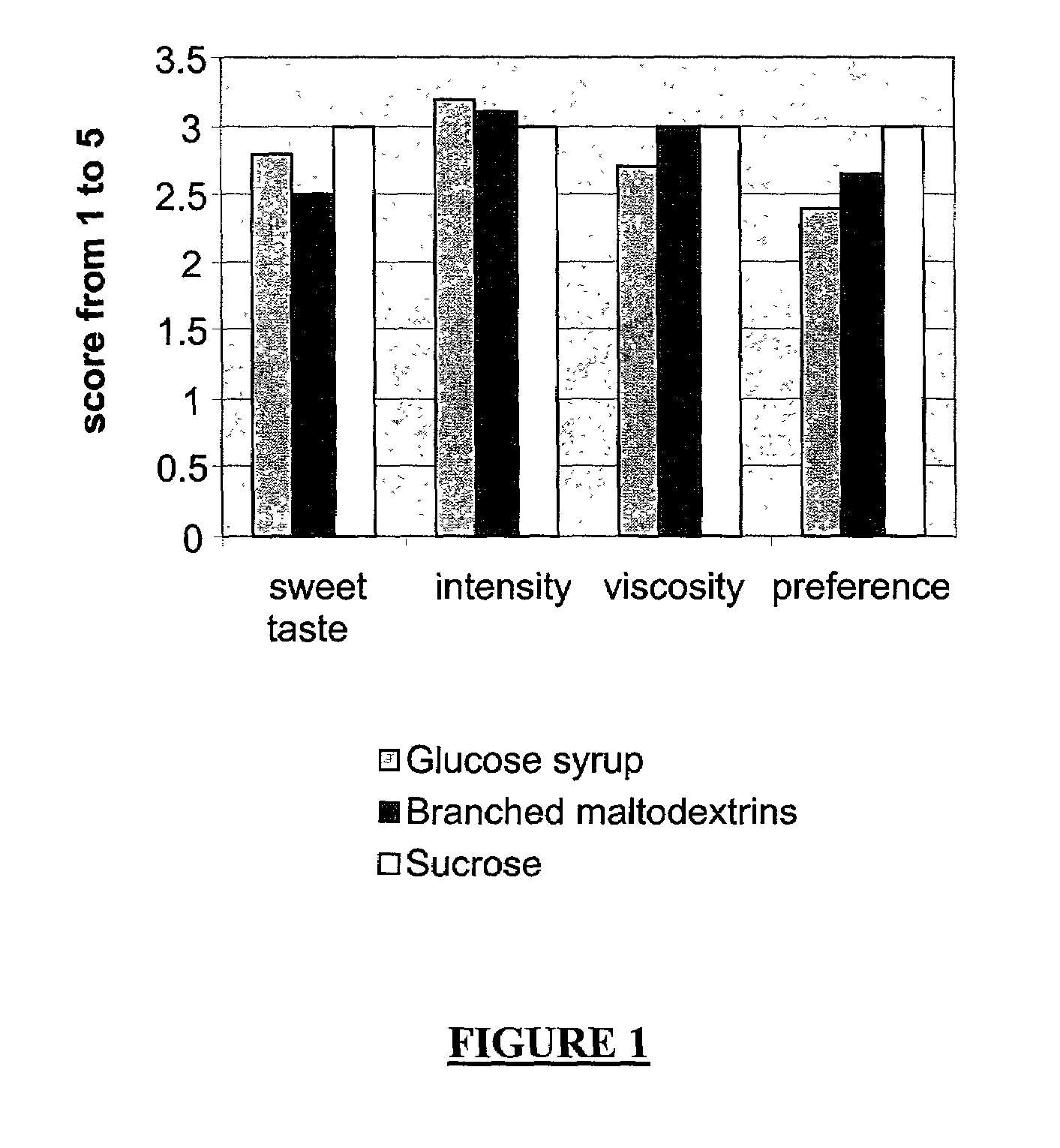Process for preparing a low-calorie food
a low-calorie food and processing technology, applied in the field of low-calorie food preparation, can solve the problems of serious hyperglycaemia in patients, food containing polyols that may give rise to criticism, and the nutritional properties of foods may not be fully understood, so as to reduce calorific value, improve rheological behaviour, and reduce the effect of manufacturing tim
- Summary
- Abstract
- Description
- Claims
- Application Information
AI Technical Summary
Benefits of technology
Problems solved by technology
Method used
Image
Examples
example 1
Biscuit
[0037]Traditional biscuits and biscuits containing, on the one hand, branched maltodextrins and, on the other hand, FOSs (fructooligosaccharides), are prepared. The latter products are marketed under the name ACTILIGHT or RAFTILOSE.
[0038]
Quantities per 100 g of dough:Ingredient (weight inBiscuit accordingBiscuitgrammes)Referenceto the inventionwith FOSFlour55.855.855.8Fat15.912.412.4Sucrose17.815.115.1Branched maltodextrins06.20FOS006.2Water9.39.39.3Ammonium bicarbonate0.30.30.3Sodium bicarbonate0.20.20.2Sodium pyrophosphate0.20.20.2Salt0.30.30.3Vanilla0.10.10.1Lecithin0.10.10.1
Procedure:[0039]Weigh the water, the ammonium bicarbonate and the sodium bicarbonate. Mix for 5 minutes in a Hobart kneader on speed 1.[0040]Add the fat and the soya bean lecithin, and stir for 1 minute on speed 1, and then for 4 minutes on speed 2.[0041]Weigh the rest of the powders (flour, sucrose, sodium hydrogen pyrophosphate, salt and vanilla flavour). Mix them, and then add them to the kneader. S...
example 2
Cereal Bars
[0052]Cereal bars are prepared with glucose syrup (control) or by replacing part of this syrup with branched multidextrins so as to reduce the calorific value of the bars.
Binding Caramel Recipe
[0053]
TRIAL ACCORDING TOCONTROLTHE INVENTIONCOMPOSI-COMPOSI-TIONTIONINGREDI-OF THEINGREDI-OF THEENTSPRODUCTENTSPRODUCTUSEDFINISHEDUSEDFINISHED(by weight)(%)(by weight)(%)Powdered milk10110.610110Sucrose30033.530032Branched——12612.7maltodextrinsNaCl40.440.4Water83—40—NEOSORB1007.81188.870 / 70*FLOLYS23321.113211E70815*VF** COSE17419.417418Soya bean50.650.5lecithinResidual—6.5—6.6moistureTotal10001001000100*Marketed by the applicant**Vegetable fat
Procedure[0054]Mix the whole milk powder with sucrose (M1).[0055]Mix the water, the NEOSORB 70 / 70 and the FLOLYS E7081S (M2).[0056]Mix the vegetable fat (previously melted at 50° C.), the lecithin and the branched maltodextrins (M3).[0057]With stirring, add the mixture M1 to the mixture M2 and then boil on a low fire until 110° C. is reached.[0...
example 3
Preparation of Fizzy Soft Drinks
[0072]Fizzy soft drinks containing, on the one hand, sucrose, and, on the other hand, a glucose syrup and branched maltodextrins as a complete substitute for sucrose, are prepared.[0073]Quantities in grammes per 1 liter of drink:
[0074]
Trial 2ControlTrial 1(according to the(sucrose)(glucose syrup)invention)Sucrose100Glucose syrup86.42Branched73.68maltodextrinsAspartame0.0780.118Acesulfame K0.0780.118Lemon flavour0.70.70.7Citric acid1.91.91.9(dry)Sodium benzoate0.090.090.09(dry)Carbonatedq.s. 11q.s. 11q.s. 11water at 4° C.[0075]Sucrose: sieved manufacturer's sugar (BEGHIN-SAY)[0076]Glucose syrup: FLOLYS®E7081S[0077]Aspartame: NUTRASWEET[0078]Acesulfame K: HOESCHT[0079]Lemon flavour: AG 31711 (QUEST)
[0080]The branched maltodextrins represent between 15 and 35% of 1→6 glucoside linkages, a reducing sugar content of between 2 and 5%, a polymolecularity index of less than 5 and a number-average molecular mass Mn of between 2000 and 3000 g / mol:
[0081]
Reducing...
PUM
| Property | Measurement | Unit |
|---|---|---|
| temperature | aaaaa | aaaaa |
| temperature | aaaaa | aaaaa |
| volume | aaaaa | aaaaa |
Abstract
Description
Claims
Application Information
 Login to View More
Login to View More - R&D
- Intellectual Property
- Life Sciences
- Materials
- Tech Scout
- Unparalleled Data Quality
- Higher Quality Content
- 60% Fewer Hallucinations
Browse by: Latest US Patents, China's latest patents, Technical Efficacy Thesaurus, Application Domain, Technology Topic, Popular Technical Reports.
© 2025 PatSnap. All rights reserved.Legal|Privacy policy|Modern Slavery Act Transparency Statement|Sitemap|About US| Contact US: help@patsnap.com

